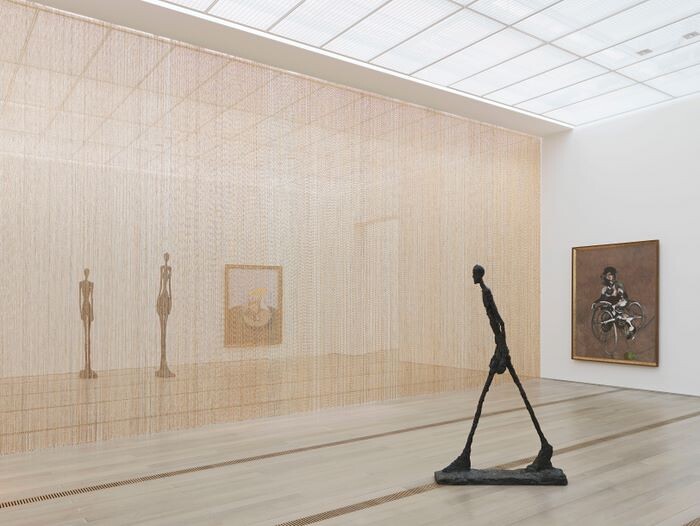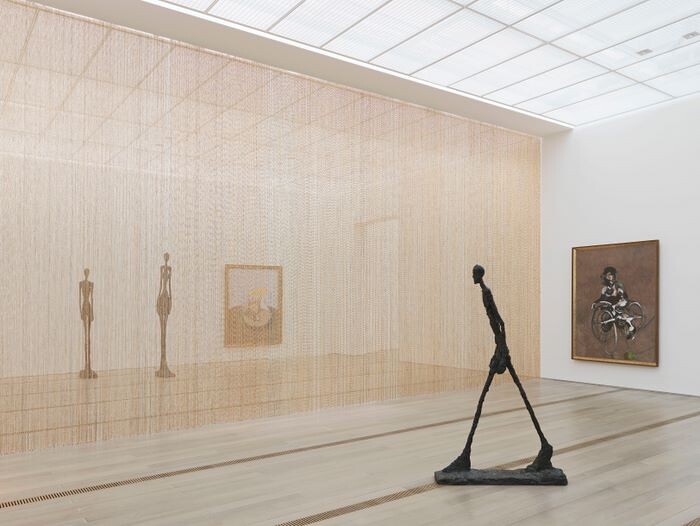May 22–August 29, 2010
It was a profoundly disorienting encounter: in a room of Picasso paintings at the Fondation Beyeler, I suddenly came across a tall, muscled, black man in a pair of silver hot pants dancing silently and joyfully to music on his headphones. This go-go dancer atop a small, square white platform—both clubby stage and arty pedestal—was ringed by a crowd of silver-haired Swiss art patrons, dazzled and confused. If the white, incandescent bulbs that neatly rimmed the minimal stage alluded to the gay clubs (and their cultural politics), they also conjured the artist behind them, who turned ordinary strands of light bulbs into a series of now seminal contemporary art works—at once formalist and conceptual, poetic and political—in the 1980s and 90s.
My encounter with Felix Gonzalez-Torres’s work “Untitled” (Go-Go Dancing Platform) (1991), should not have caused such surprise; I was, after all, at the Beyeler to see the second stop of his retrospective, deftly organized by Elena Filipovic for the Wiels Contemporary Art Centre, Brussels. But such is the arresting power of the Cuban-born artist’s seemingly simple works and interventions that they nearly always cause a moment of both mental and physical frisson, even when one has seen them before.
Such subjectivity is at the heart of Gonzalez-Torres’s oeuvre, and of Filipovic’s sensitive show. In a talk at Art Basel, Filipovic elaborated: “I wanted to make an exhibition that would undo its own authority… [that would] show its subjectivity in each case.” To do so, the survey has a novel structure: at each of its three stops, Filipovic has invited an artist to come in halfway through and re-install. At Wiels, Danh Vo distilled Filipovic’s chosen 50 works into 17. Carol Bove will follow next month at the Beyeler, where she intends to recreate Andrea Rosen’s Gonzalez-Torres show mounted at her gallery in 1991. Tino Sehgal, meanwhile, will be on hand for the last stop in Frankfurt next year.
It’s an eccentric curatorial structure. At the Beyeler, for example, the curator decided to place Gonzalez-Torres’s works in direct conversation with the museum’s formidable (and unmovable) collection of modernist art. Thus, “Untitled” (For Stockholm) (1992), a waterfall of light bulbs and cords, falls to the floor near some Barnett Newman paintings and sculptures, mirroring the verticality of the Newman works while deftly defying their density and weight. Likewise, in the gallery of lily-pond paintings by Monet—separated by a glass wall from the actual lily pond outside—Filipovic placed a paper stack featuring the hazy surface of a body of water. The work transforms the monumentality of Monet’s paintings and Renzo Piano’s landscaping into something as temporal and elusive as a photocopied image. In contrast with the turbulent mental states projected in a room of Alberto Giacometti’s attenuated sculptures and Francis Bacon’s hallucinatory portraits, Gonzalez-Torres’s beaded curtain “Untitled” (Golden) (1995), seems pacific and infinitely private.
Although this conversation between modernist masterpieces and Gonzalez-Torres’s postmodernist work is instructive, the conceit does wear thin. Thus, the galleries downstairs devoted to his works alone come as a relief. The last room, in particular, is a revelation. Its discreet constellation of works include an untitled 1994 photographic diptych featuring a glittery chandelier, each image taken a few seconds apart, as well as the improbably moving C-print “Untitled” (Jorge) (1992), which discloses a string of lights, in the faint shape of a body, in the water. The work’s personal subtitle gives it a distinctly human quality and address, turning it into a lament of sorts; furthering this feeling is the artist’s directive, which stated that this is the only print of the image that can ever be made.
At the center of the room, a trail of bulbs and cords (“Untitled” [Summer], [1993]) leads to two vertical mirrors (“Untitled” [Orpheus, Twice], [1991]). The latter piece alludes to the musician-poet of Greek myth, who famously lost his wife Eurydice to Hades when he turned to catch a glimpse of her as they returned from the underworld. It’s an event memorialized by Rilke, among others, which seems fitting, because despite his formal rigor and political engagement, Gonzalez-Torres seems to be, above all else, a love poet. Though not one who rejected the world for the love object; instead, Gonzalez-Torres imbued that world—as embodied by its most quotidian materials—with his ardor and fast intelligence, turning each thing on which he fastened his gaze, from the most mundane to the most painful, into a love letter.






